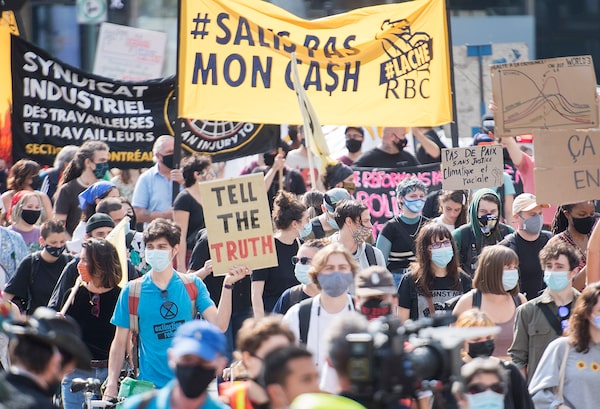
People attend a protest calling for stronger climate action in Montreal, Saturday, Sept. 26, 2020.Graham Hughes/The Canadian Press
The stage is set for climate change to dominate the early weeks of the next government’s term.
Monday’s election will barely be in the rearview mirror before attention turns to COP26 – a landmark United Nations climate summit, scheduled for the first two weeks of November in Glasgow, where world leaders will try to set a path to reduce greenhouse gas emissions during a pivotal decade for the planet.
That will be a big test, under a bright spotlight, of Canada’s ability to play a constructive role in confronting the global crisis. It will necessitate conveying a credible plan to meet our emissions-reduction commitments, currently set at a 40-per-cent reduction from 2005 levels by 2030. It will also involve trying to prove that Ottawa can punch above its weight in developing global climate solutions, including international trade mechanisms and financing to help developing economies meet the challenge.
The timing should ensure that, at least publicly, there is a strong early sense of momentum around meeting climate-policy commitments made during the campaign.
But it’s behind the scenes where the real work will have to start happening as soon as the next cabinet is sworn in, and where that work will need to continue with unprecedented urgency and consistency if Canada is to meet its obligations while competing economically in a decarbonizing world.
Housing, climate change, long a preoccupation for B.C., take centre stage in national vote
Canada’s 2021 federal election platform guide: compare where the parties stand on top issues
Although it was not readily apparent from the stinted public discussion on the subject during the campaign, this election went a significant distance toward establishing consensus on some of the key steps needed for a clean-economy transition, many of which will require a great deal of focus and resolve to fully achieve.
Those agreed-upon steps include, for instance, the implementation of a zero-emissions vehicle mandate, which means a sales quota to accelerate the transition away from gasoline-fuelled passenger vehicles to electric ones. That may sound simple enough, but it will involve complicated regulatory design, while under pressure from the auto sector to water down the commitment. The government will also have to work quickly on supplemental measures, such as expanded charging infrastructure. And it will need to develop sophisticated industrial strategy to make good on campaign-trail promises to leverage the growing electric-vehicle market into a Canadian EV supply chain.
Even more complex to act upon will be a promised strategy to reduce emissions from Canadian buildings, by lessening their reliance on fossil fuels for heating and by improving their energy efficiency. That will mean going beyond relatively small grants for home retrofits that the Liberals rolled out prior to the election, and into much more sophisticated measures – including working with larger real estate owners, the construction industry and others to ensure that the right financing, materials and expertise are sufficiently available to really transform the country’s building stock.
There was some overdue recognition in parties’ agendas this campaign that Canada needs to more actively engage in electricity-grid modernization, to ensure an adequate supply of clean power for electrification of transportation and buildings (not to mention industry). But doing so will require great determination to break through the constraints of Canadian federalism, which gives Ottawa little jurisdiction in this area, and find ways to expedite investment in everything from interprovincial electricity transmission to smart-grid technology.
There are so many other aspects of climate policy where similar recognition of the need for greater ambition requires quick translation into action. Ottawa will need to create mechanisms to encourage greater clean-technology investment, provide help for hard-to-decarbonize sectors, and work with rural communities and sectors on nature-based solutions.
Plus, there is the entire matter of building resilience to climate change consequences – extreme heat, wildfires, floods – that are to some extent already unavoidable. Adaptation, which often gets short shrift from parties wary of seeming defeatist about averting those consequences altogether, got more emphasis in this campaign than in any previous one. The parties’ platforms included some specific promises around infrastructure, emergency services and insurance. But the federal government will have to work closely with communities bearing the brunt of the impacts as it implements those sorts of policies, to make sure their actual needs are being met.
All of this will be competing for attention with plenty of other priorities, of course, as the government plots economic recovery from the COVID-19 pandemic amid mounting anxieties about the cost of living, and about the exacerbation of economic inequalities and regional tensions.
But that can’t be an excuse for effort on climate to be intermittent. The international lens, courtesy of the Glasgow summit, may give it an early advantage in prioritization. The proof will be in what follows.